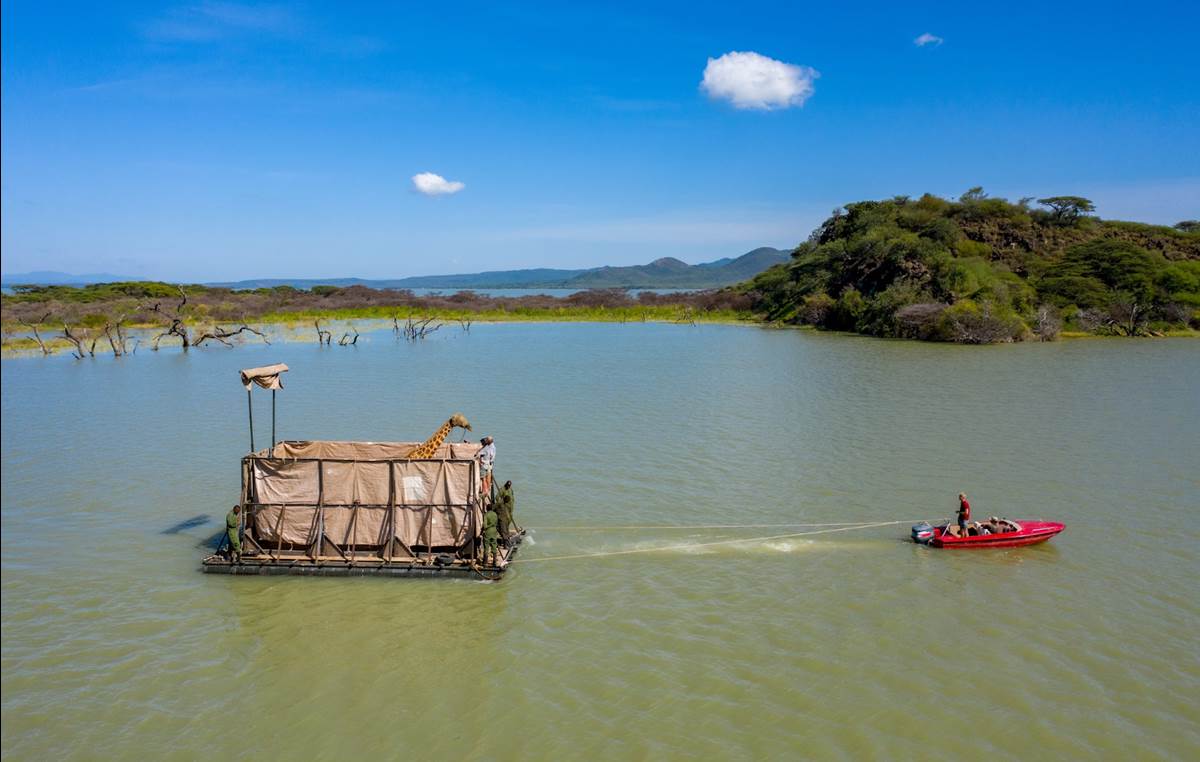The Story of How 8 Giraffes Were Rescued from a Flooded Island is Recounted in “Giraffes on a Boat” episode of “Overheard at National Geographic”
“Giraffes on a Boat” is not the sequel to a Samuel L. Jackson movie, but the title of the 5th episode of the 6th season of Overheard at National Geographic. In the June 1st episode of the informative podcast, co-host Amy Briggs introduces listeners to David O’Connor, a conservationist and president of Save Giraffes Now who helped save eight giraffes trapped on an island. This is a recap of the daring rescue depicted in this exciting episode.

(National Geographic/Ami Vitale)
Giraffe populations have declined by over 40% over the last three decades, primarily due to habitat loss and poaching. Among the most endangered are the Rothschild’s giraffes, who were wiped out of the Western Rift Valley in Kenya 70 years ago. It is estimated that only 800 remain in Kenya and the community in the valley are trying to restore the population.
Ten years ago, conservationists relocated 8 Rothschild’s giraffes to a peninsula along the freshwater Lake Baringo, with three sides protected by water making it more difficult for poachers to reach them. The plan was that these 8 giraffes would have babies and help repopulate the area, but when the lake flooded, the peninsula became an island… and giraffes can’t swim. The flood waters rose in 2020 and all 8 giraffes, plus a newborn calf, were stuck on a small island where crocodiles pass through, running out of food and becoming underweight. Human intervention was needed in order for these 8 giraffes, representing 1% of their entire species, to be saved.
While most of the giraffes remained together, a female named Asiwa ended up on a small elevated strip of land that got cut off from the rest of the island, trapping her apart from the rest of her tower. 19 feet tall and weighing one and a half tons, although the island was small, the dense brush made it hard to find her. On top of that, giraffes are skittish and Asiwa had been in a high-stress situation for several months. Rescuing her was not going to be easy.
With tall, thin, wobbly legs, giraffes were not designed with boat travel in mind and David O’Connor and his team had to secure funding to create a floating vessel that could transport them with very little movement. A custom-built barge was designed, using layers that include oil barrels, flat platforms and compacted earth was built and named the “GiRaft.” With Asiwa in the highest risk situation, she would become the first passenger to board.
Plan A for luring Asiwa onto the GiRaft was acacia seed pods, a favorite snack of giraffes, but it didn’t work. Plan B was sedation, a dangerous task because unlike other large mammals, giraffes are not meant to lay down on their sides. In fact, it can pose life threatening challenges if they do go horizontal, most commonly a giant brain hemorrhage from loss of blood pressure. The plan was for a vet from Kenya Wildlife Service to use a dart to give Asiwa the sedative, to be followed up immediately by an antidote. However, giraffes respond differently to the sedative and many of them take off and run, presenting new challenges if they trip in the process. In Asiwa’s case, she turned out to be a runner.
It was a nerve wracking experience for David and his team chasing after Asiwa through dense brush, with local press on hand to witness the high profile transport. Asiwa gave the conservationists a good, heart-pounding chase away from the barge to the opposite side of her small island before falling over about a foot from the edge of the water, where the vet was able to quickly administer the antidote that saved her life. Using a blindfold to cover her eyes and socks stuck in her ears to drown out alarming sounds, they were able to lure Asiwa safely back to the GiRaft for its maiden voyage with an extra large passenger.
Towed across the lake by a motorboat, Asiwa walked off the GiRaft onto the mainland, becoming the first to step hoof in the Western Rift Valley in over 70 years. The community was present to cheer and applaud the return of giraffes to the area. Throughout 2020 and 2021, the GiRaft made trips back to the islands to rescue the rest of Asiwa’s tower and they are all on the mainland thriving, calf included.
Another guest in this episode was Arthur Muneza, a National Geographic Explorer from Kenya who shared that the local communities of the Western Rift Valley have devoted land to restorying the giraffe population. An organization called Twiga Walinz is Swahili for “Giraffe gods” and is dedicated the training communities to collect data on giraffes to help protect them.
David O’Connor estimates that it will take at least 20 years for this population of giraffes to repopulate the entire Western Rift Valley, possibly up to 40 years to achieve that dream. However, the process can be sped up with donations. As for the GiRaft, the community plans to turn it into a floating bar-restaurant to attract tourists to the region now that the giraffes have been saved from the island.
You can listen to this full episode and others at the official Overheard at National Geographic website.
